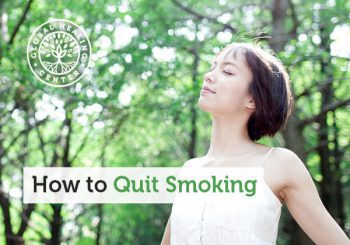Guest Writer for Wake Up World
For smokers, quitting is — by far — the most important step you can take to improve your health as well as that of your family. Maybe you’re worried about the harm cigarettes have caused your body, concerned about the effects of second-hand smoke on those around you, or feel like your tobacco use comes at a high cost. Whatever your motivation, remember that quitting smoking is a journey that requires a plan of action. Making the firm decision to quit is the first step on your path to better health.
Six Steps to Quit Smoking for Good
There are many effective ways to quit smoking, and while no one method works for everyone, following these steps can help you along your path to living a smoke-free life.
1. Pick a Quit Date
After you set a date, add it to your calendar to help you stick to it. Select a date that gives you enough time to build the confidence and willpower you need to successfully quit, but isn’t so far ahead that you may start second-guessing your decision.
2. Remove All Nicotine Products
The night before your quit date, get rid of your cigarettes and any triggers, such as lighters or ashtrays, that you associate with smoking. Don’t tuck them away “just in case.” Throw them out to remove the temptation and reinforce the reality of your decision. Also, clean your home, your car, and any other places where you’ve smoked to remove the odor of cigarettes.
3. Get Quitting Aids (If You Need Them)
Some people find that nicotine replacement therapies (NRT) like gum, inhalers, nasal sprays, and patches increase their chances of overcoming their addiction. If you opt to use one of these aids, it should only be temporary.[1] If you use NRTs or quit cold turkey, stock up on oral substitutes like gum and toothpicks to help distract you when a craving hits. Other natural options to help you kick the habit include hypnosis, acupuncture, and support groups.[2]
4. Know Your Smoking Triggers
Cravings are a normal part of quitting smoking. For most people, certain things will trigger an urge to smoke. If you’ve cleaned everything and removed the scent of smoke, you’ve already eliminated one common trigger. Consider tracking your smoking habit before you quit, and pay attention to any patterns in your smoking behavior, such as after meals, after sex, or during times of stress. Have a specific plan for each of these situations.
5. Ask for Support
Having support is crucial to quitting.[3] Friends, family, your healthcare practitioner or other smokers who have successfully quit can provide emotional support and encouragement. Tell people in your life that you’re quitting, and be clear about what you need from them. Do you want a friend to call every day to check in with your progress and hold you accountable? Do you need a friend you can call whenever you want to pick up a cigarette, to talk you out of it, acting as a “sponsor” of sorts? Do you need your family members to remind you of the reasons why you’re quitting? Identify what will help you succeed and then ask for it.
6. Stay Busy
When you feel the urge to smoke, do something to distract yourself. Stretch, go for a walk, take a shower, or call a friend. Cravings rarely last more than a few minutes, so any time you feel one coming on, take a moment to do something different. Take ten deep breaths, chew some gum, or take a whiff of peppermint essential oil and wait for the craving to pass.
Health Effects Timeline
No matter how long you’ve been smoking, your body will begin to heal, and your health will improve soon after you quit. You will notice some changes right away, while others become more noticeable as time goes on.
These changes occur after your last cigarette:[4]
- 20 minutes: Your heart rate and blood pressure return to a normal range.
- 8 hours: Your body’s oxygen levels return to normal and risk of a heart attack decreases.
- 24 hours: Your lungs begin to clear out the mucus caused by smoking. Coughing is normal at this stage.
- 48 hours: Your sense of smell and taste start to return.
- 2 weeks to 2 months: Your lung function increases up to 30 percent.
- 1 year: Your risk of heart attack is cut in half.
- 10 years: Your risk of dying from lung cancer is cut in half.
- 20 years or more: Your risk of getting heart disease is the same as someone who has never smoked.
Benefits of Quitting Smoking
The health benefits of quitting are the same for all types of smokers no matter your gender, age or how long you’ve been smoking. Although giving up this bad habit is challenging, the benefits are worth it. Here are the top six benefits.
Reduce Your Risk of Cancer
Along with improving your heart health, reducing your cancer risk is one of the major health benefits of quitting smoking. Smokers are almost 20 times more likely to die of lung cancer than non-smokers.[5] Smoking also increases the risk of other types of cancer, and when you quit, you significantly reduce your risk of developing this invasive and life-limiting disease. Start your journey to better health today!
Lower Your Cholesterol
Smoking reduces the amount of high-density lipoproteins (HDL) in your blood, which is the “good” cholesterol that protects against heart disease.[6] HDLs carry bad cholesterol (low-density lipoproteins, or LDL) to the liver, so that it can get flushed from the body. Without HDLs, your risk for arterial plaque buildup increases, leading to heart disease. Research shows that smokers have a 2 to 4 times greater chance of developing heart disease than nonsmokers. So, when you stop smoking, you lower your bad cholesterol which, in turn, decreases your risk of heart disease.[7]
Improve Your Blood Pressure
Every time you have a cigarette, your heart rate and blood pressure rise.[7] Within hours of quitting, both your heart rate and blood pressure go down.
Boost Your Immune System
Quitting smoking lowers inflammation in your body, improves circulation, and increases oxygen levels — all of which have a positive effect on your immune system. With a stronger immune system, your body can more easily fight off viruses and illnesses.[8]
Clearer Skin
Tobacco smoke causes premature aging and makes you look older by causing wrinkles and sagging skin.[9] The nicotine in cigarettes constricts your blood vessels, depriving your skin of oxygen and nutrients. Once you are smoke-free, your skin will look more vibrant and healthy.
Taste Buds Improve
Smoking damages nerve endings in your mouth and nose, which dulls your senses of taste and smell.[10] Within just 48 hours of quitting, you will start to notice that food and drinks taste better as the nerve endings in your mouth begin to heal.
While they aren’t side effects per se, your body has become addicted to nicotine, and as it eliminates the poison from your body, you may experience a healing crisis as you adjust to living tobacco-free, particularly in the early stages of your quitting journey. These include:
Nicotine Withdrawal
Nicotine is a drug, and it’s why smoking is addictive.[11] When you quit smoking, your body will go through nicotine withdrawal as it adjusts to going without. Withdrawal symptoms can last up to two weeks, but you are likely to experience the most difficult symptoms during the first few days. Just remember that these symptoms will pass, and to stay determined to live a smoke-free life.
Inability to Sleep
Nicotine withdrawal can interfere with sleep for a few weeks as your body adjusts, and you may experience bouts of insomnia.[12] Meditate or stretch before bed to relax your mind and body. Reduce your caffeine intake during the day and stay physically active to ensure that you get a good night’s sleep.
Irritability
Feeling irritable is a normal part of nicotine withdrawal.[13] Let your family and friends know that you may be a bit grumpy over the next couple weeks as you adjust physically and mentally to this new state of health. Light exercise such as walking and yoga can help improve your mood, as can meditation and breathing exercises. Aromatherapy with essential oils can work wonders on your mood.
Constipation
Constipation and other digestive issues are normal in the first few weeks after you quit.[14] Drink plenty of water and increase your fiber intake by eating plenty of fruits, vegetables, and whole grains to help your body return to more regular bowel movements.
Increased Appetite
Your body may confuse nicotine cravings for food cravings, causing an increased appetite.[15] This can last for several weeks after your quit. Try eating smaller amounts of healthy foods throughout the day rather than three large meals.
Difficulty Concentrating
For the first two weeks of being smoke-free, you may have difficulty focusing or experience “brain fog.”[13] Know this is normal. Eat throughout the day to help maintain steady blood sugar, which can also make it easier to stay focused.
Fatigue
Nicotine is a stimulant, so when it’s gone, you might feel tired.[14] It can take a few weeks for your energy levels to return to normal as your body adjusts. In the meantime, get more rest, exercise (which gives you more energy and helps you sleep), and drink lots of water to flush your system.
Best Tips for Long-Term Success
Even after most of your cravings and nicotine withdrawals have passed, staying smoke-free can be challenging. There are things you can do to avoid slip-ups and set yourself up for long-term success.
Eat Detoxifying Foods
A healthy diet can help you eliminate the toxins that build up over time from smoking. Consume lung-cleansing foods, such as pistachio, plantain leaf, and cayenne pepper. Drinking a cup of ginger root or green tea each day can help flush your body of toxins. Limit your intake of processed and fried foods.
Drink Plenty of Water
Drinking water doesn’t just keep you well-hydrated, it also breaks down chemicals and flushes them out of your body. This directly helps you eliminate the toxins caused by smoking. Drinking water can also help you combat cravings. Hold each sip in your mouth for a few seconds when a craving strikes, or drink through a straw to keep your mouth busy.
Meditate
Quieting the mind through meditation is a great way to get through cravings. Meditation not only focuses your thoughts, but it encourages a happy, balanced mood. You will gain the most benefits of meditation if you practice daily. Try picking a time and place every day that you can dedicate five to ten minutes to meditate. If you need more direction on meditation, check out our article Meditation for Beginners: A Guide to Inner Tranquility.
Exercise
You can increase your chances of successfully quitting while improving your health by reaching for your gym shoes instead of cigarettes.[16] Thirty minutes of exercise each day is an effective way to boost your mood and help you get better sleep — all of which will help keep cravings and withdrawal symptoms at bay.
Breathing Exercises
Deep breathing can help you get through cravings. When a craving hits, inhale through your nose and hold it for a count of five. Slowly breathe out through your mouth for a count of seven. Repeat as many times as necessary to reduce your cravings, stress, and anxiety. Deep breathing exercises are great to perform while sitting still in a quiet room or even while going for a walk outside in nature.
Infrared Sauna
Infrared (IR) saunas help detoxify your body through the use of heat. Just 10 to 15 minutes can work up a vigorous sweat and remove toxins, promote circulation and healing, decrease pain and fatigue, and improve skin tone and elasticity. Be sure to drink plenty of water before and after your sauna sessions.
Do a Lung Cleanse
A lung cleanse is a natural procedure designed to detoxify, cleanse, and refresh the delicate respiratory linings of the bronchial passages and lungs by purging them of accumulated toxins.
Try Vitamins & Herbs for Lung Health
There are a number of lung cleansing herbs, such as oregano, eucalyptus, and lungwort, that will provide nutrition for your respiratory system. Various vitamins are available to also support lung health. You can even try castor oil packs for lung cleansing.
Points to Remember
Quitting isn’t easy, but it can be done! As you go along your quitting journey, it’s important to remind yourself of the reasons why you’re quitting, particularly when you feel the urge to smoke. Make a list of your reasons and read them to yourself often to help you stay the course. When you want to quit, put the date on the calendar. Enlist people to help support you, especially friends or family members who are former smokers themselves. Know your triggers — things that make you want to smoke — and eliminate them. Have a plan to distract yourself whenever a craving comes on. Know that when you quit smoking, you are doing the single most important thing for your health and it will only improve with time.
For long-term success, increase your physical activity, eat detoxifying foods, engage in breathing exercises, and cleanse your body. The freedom you will experience after you’ve successfully quit will be incredible. It won’t take long before you’re a healthier, happier version of yourself!
Sources and References:
- Silagy C, et al. The effectiveness of nicotine replacement therapies in smoking cessation. Online J Curr Clin Trials 1994; Doc No 113.
- Tahiri M, et al. Alternative smoking cessation aids: A meta-analysis of randomized controlled trials. Am J Med. 2012; pp.576-584.
- Orleans CT, et al. Self-help quit smoking interventions: effects of self-help materials, social support instructions, and telephone counseling. J Consult Clin Psychol. 1991 Jun;59(3):439-48.
- Changes Your Body Goes Through When You Quit Smoking. University of Michigan Health System, Tobacco Consultation Service. 2005. Accessed 16 Oct. 2018.
- Ozlü T, Bülbül Y. Smoking and lung cancer. Tuberk Toraks. 2005;53(2):200-9.
- Garrison R, et al. Cigarette smoking and HDL cholesterol the Framingham offspring study. Atherosclerosis. 1978;30(1):17-25.
- The Health Consequences of Smoking—50 Years of Progress: A Report of the Surgeon General. U.S. Department of Health and Human Services, Centers for Disease Control and Prevention, National Center for Chronic Disease Prevention and Health Promotion, Office on Smoking and Health. 2014. Accessed 17 Oct. 2018.
- Arnson Y, et al. Effects of tobacco smoke on immunity, inflammation and autoimmunity. J Autoimmun. 2010;34(3): J258-J265.
- Morita A. Tobacco smoke causes premature skin aging. J Dermatol Sci. 2007;48(3):169-175.
- Sato K, et al. Sensitivity of three loci on the tongue and soft palate to four basic tastes in smokers and non-smokers. Acta Otolaryngol Suppl. 2002;(546):74-82.
- Stolerman I, Jarvis M. The scientific case that nicotine is addictive. Psychopharmacology (Berl). 1995;117(1):2-10.
- Jaehne A, et al. Effects of nicotine on sleep during consumption, withdrawal and replacement therapy. Sleep Med Rev. 2009;13(5):363-377.
- Shiffman S, Jarvik M. Smoking withdrawal symptoms in two weeks of abstinence. Psychopharmacology (Berl). 1976;50(1):35-39.
- Cummings K, et al. Reports of smoking withdrawal symptoms over a 21 day period of abstinence. Addict Behav. 1985;10(4):373-381.
- Filozof C, et al. Smoking cessation and weight gain. Obes Rev. 2004 May;5(2):95-103.
- Ussher MH, et al. Exercise interventions for smoking cessation. Cochrane Database Syst Rev. 2008;(4):CD002295.
Originally published at Global Healing Center and reproduced here with permission.
Recommended articles by Dr. Edward Group:
- What are Whole Foods and Why are They Important for Health?
- Top Vitamin C Benefits for the Skin
- Wim Hof Breathing: 6 Benefits for Body and Mind
- Camu Camu: The Next Great Superfood
- Emotional Freedom Technique (EFT): 5 Benefits and How To Do It
- Enokitake Mushrooms: 7 Benefits of this Superfood
- Here are 7 Reasons to Try a Cleanse
- 3 Scientifically Proven Ways Meditation Boosts Your Immune System
- What is Candida? Understanding Yeast Imbalance
- Acerola Cherry: 8 Benefits of this High-C Tropical Super Fruit
About the author:
Dr. Edward F. Group III (DC, ND, DACBN, DCBCN, DABFM) founded Global Healing Center in 1998 with the goal of providing the highest quality natural health information and products. He is world-renowned for his research on the root cause of disease. Under his leadership, Global Healing Center earned recognition as one of the largest natural and organic health resources in the world. Dr. Group is a veteran of the United States Army and has attended both Harvard and MIT business schools. He is a best-selling author and a frequent guest on radio and television programs, documentary films, and in major publications.
Dr. Group centers his philosophy around the understanding that the root cause of disease stems from the accumulation of toxins in the body and is exacerbated by daily exposure to a toxic living environment. He believes it is his personal mission to teach and promote philosophies that produce good health, a clean environment, and positive thinking. This, he believes, can restore happiness and love to the world.
For more, please visit Global Healing Center.
What if your life’s challenges and triumphs mirrored the sacred cycles of the universe? The Four Paths of Creation Spirituality—Via Positiva, Via Negativa, Via Creativa, and Via Transformativa—offer a transformative framework for aligning with these cycles to revitalize your purpose, creativity, and well-being.
This free online event will teach you how these spiritual paths integrate with cosmic energy to inspire your inner growth and creative potential. From embracing life’s joys to navigating its uncertainties, you’ll explore how these paths can guide you toward living authentically and vibrantly.
Don’t miss this opportunity to connect with sacred energy and discover your place in the universe’s unfolding story. Sign up today to transform your life and creativity!
If you’ve found value in our articles, we invite you to support the release of our brand-new book, “Gratitude Practices for Kids: A Practical Guide for Adults to Instill a Spirit of Appreciation and Positivity in the Next Generation.“
“Gratitude Practices for Kids” brings together over 25 innovative and accessible practices designed to enhance gratitude in everyday life. This comprehensive guide is backed by 17 scientific studies, ensuring each concept is grounded in research, underscoring our commitment to nurturing growth, emotional intelligence, and positive interactions between adults and children.
We encourage you to opt for the paperback version to celebrate this new release. Dive into its fresh pages away from digital distractions, allowing you to immerse yourself in the transformative practices it offers.
Over recent years, Wake Up World has faced significant online censorship, which has impacted our financial ability to operate. Moving into book publishing represents a strategic step to secure the ongoing funds needed to continue our mission. By purchasing Gratitude for Kids, you help us keep our content free and accessible to everyone, avoiding needing a paywall. With over 8,500 articles published in the last 13 years, we remain dedicated to keeping our valuable content open to all.











